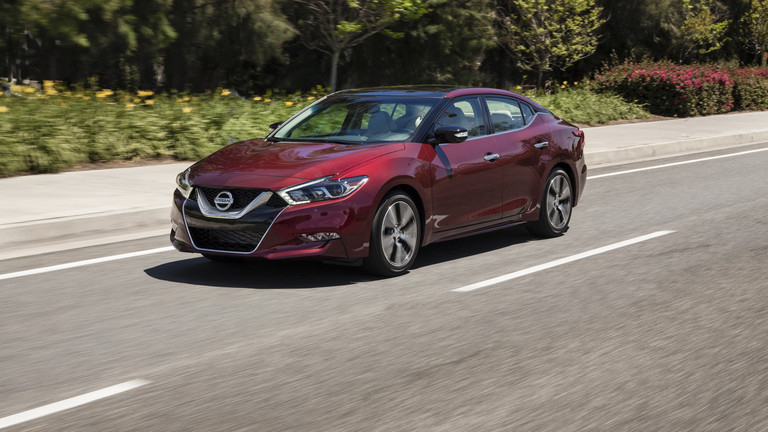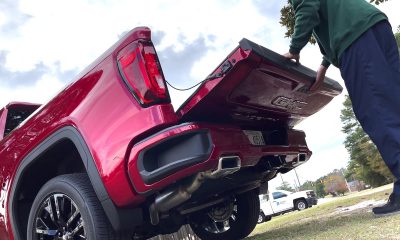Transportation
Car Review: 2016 Nissan Maxima

By Frank S. Washington
NNPA Columnist
PLYMOUTH, Mich. (NNPA) – You’ve got to give Nissan credit. The automaker has always been a little bit different; intrepid when it comes to going places where no others dare. This time the variance involved its flagship sedan, the Maxima, and how the company has incorporated its new futuristic design language into the car. In a phrase, you’re either going to love or loathe the 2016 Nissan Maxima.
But love it or hate it, no one is going to say the car is boring. Nissan continues to dub its flagship sedan as the 4-Door Sports Car. In fact, 4DSC was inside the taillight reflectors and the headlights.
From any angle, the 2016 Maxima was different. It had what Nissan called a V-Motion front end that included a dual V-shaped grille. The car had boomerang daytime running lights that curved around the inside of the headlamp housing and it had black A, B and C pillars that enhanced its floating roof look.
The body seemed sculpted and from the side it looked like two pieces, the front end at the wheel well seemed to dip lower than the back. That was because of the accent line that plunged deeply from atop the front fender at the front door. Designers looked at jet fighter planes for inspiration and gave the Maxima a sweeping canopy style from the outside.
An inch lower and two inches longer than the car it replaced, the 2016 Maxima looked more compact on the exterior. The same jet fighter style used to design the exterior was carried over into the interior of the new Maxima; the automaker called the driver’s space the cockpit.
Nissan’s interior designers raised the center console and dropped the start stop button onto it. The button pulses with light when the driver enters the car. And they angled the center console seven degrees toward the driver. Coupled with instruments that seemed to be placed deeper in the instrument panel, the effect was a wraparound feel that no doubt the designer was after.
The new Altima featured French stitching on the dash, doors and console. These days that is not overly special. But unlike many manufacturers it was actual stitching not molding. The difference is that with natural stitching, the color of the stitch (read thread) can be easily changed. On the Maxima, the stitching can be done in several different colors.
A flat bottom steering wheel confirmed the Maxima’s sport pedigree. Nissan offers two interior materials on its flagship: diamond quilted leather seat inserts or Alcantara. Both really gave the car a sophisticated look and feel.
We got in the back seat of the Maxima and found it to be comfortable and form fitting. There was plenty of head room, leg room was expansive, and there was a bunch of hip room since the seats were bucket-like and configured for two people, though there was a third head rest back there.
The car had a radar-based collision avoidance system that not only tracked the vehicle in front of it, but would bounce the beam off the ground underneath that vehicle to detect what the car in front of it was doing. In other words, the system was capable of monitoring two vehicles ahead. And it would also monitor steering wheel input and flash a coffee cup icon in the instrument panel to tell the driver it was time to get some coffee and wake up.
Under the Maxima’s hood was a 3.5-liter V6. It was the same engine as the old car but 61 percent of the parts were different. This new motor made 300 horsepower and 261 pound-feet of torque. It was mated to a continuously variable transmission that would feign shifting under aggressive throttle input.
We found this engine to be very responsive. The transmission did “shift” under hard acceleration once but once it didn’t. We think it depends on the speed from which the hard acceleration starts. The steering on the front-wheel-drive sedan was light – almost feathery. That made the Maxima very easy to handle. The car felt light, not performance car light but it was close.
And it was relatively fuel-efficient. The 2016 Maxima had an EPA rating of 22 mpg in the city, 30 mpg on the highway and 25 mpg combined.
There will be no options on the 2016 Maxima. That’s a gamble. Instead, Nissan will provide what amounts to a bundle system. The car has five grades or trim levels that will be cumulative: S, SV, SL, SR and Platinum S includes NissanConnect with navigation, an intelligent key with push button start, remote engine start and rear view camera. SV includes those features and adds leather seats, heated front seats and side view mirrors and a front and rear sonar system. And it continues like that right up to the top of the line. Nissan called it the grade walk.
Base prices start at $31,410 and ranges to $39,860. They do not include an $825 freight charge. By most accounts Nissan was prepared to discontinue its longest continuously running nameplate but the company had a change of heart.
We don’t believe the Maxima is for everybody. But we do believe that a healthy number of consumers are going to like what Nissan has done with the 2016 Maxima.
Frank S. Washington is editor of AboutThatCar.com.
###













































